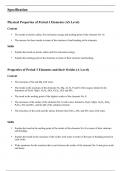Specification
Physical Properties of Period 3 Elements (AS Level)
Content
• The trends in atomic radius, first ionisation energy and melting point of the elements Na–Ar
• The reasons for these trends in terms of the structure of and bonding in the elements.
Skills
• Explain the trends in atomic radius and first ionisation energy.
• Explain the melting point of the elements in terms of their structure and bonding.
Properties of Period 3 Elements and their Oxides (A Level)
Content
• The reactions of Na and Mg with water.
• The trends in the reactions of the elements Na, Mg, Al, Si, P and S with oxygen, limited to the
formation of Na2O, MgO, Al2O3, SiO2, P4O10, SO2 and SO3.
• The trend in the melting point of the highest oxides of the elements Na–S.
• The reactions of the oxides of the elements Na–S with water, limited to Na2O, MgO, Al2O3, SiO2,
P4O10, SO2 and SO3, and the pH of the solutions formed.
• The structures of the acids and the anions formed when P4O10, SO2 and SO3 react with water.
Skills
• Explain the trend in the melting point of the oxides of the elements Na–S in terms of their structure
and bonding.
• Explain the trends in the reactions of the oxides with water in terms of the type of bonding present in
each oxide.
• Write equations for the reactions that occur between the oxides of the elements Na–S and given acids
and bases.
, Period 3 Element Trends
Electronic Configurations
Na = 1s2 2s2 2p6 3s1 P = 1s2 2s2 2p6 3s2 3p3
Mg = 1s2 2s2 2p6 3s2 S = 1s2 2s2 2p6 3s2 3p4
Al = 1s2 2s2 2p6 3s2 3p1 Cl = 1s2 2s2 2p6 3s2 3p5
Si = 1s2 2s2 2p6 3s2 3p2 Ar = 1s2 2s2 2p6 3s2 3p6
Atomic Radius
As you move across a period:
• The number of protons increases, so the nuclear charge increases.
• There is a similar amount of shielding.
• The outer electrons are in the same shell.
• The attraction between the nucleus and outer shell electron increases.
Therefore the outer electron is pulled closer to the nucleus; hence atomic radius decreases across a period.
First Ionisation Energy
As you move across a period:
• Proton number increases, so nuclear charge
increases.
• There is a similar amount of shielding.
• The atomic radius decreases.
• The attraction between the nucleus and outer shell
electron increases.
More energy is required to remove an outer shell electron
Hence first ionisation energy increases across a period, aside from various exceptions:
First ionisation energy decreases from Magnesium to Aluminium:
• Magnesium’s outer electron is in a 3s orbital; aluminium’s outer electron is in a 3p orbital
• The 3p orbital is slightly further from the nucleus than the 3s orbital, so the attraction between the
nucleus and outer electron is less for aluminium
• The 3p orbital is slightly shielded by the 3s orbital, so the attraction is lessened further for aluminium
First ionisation energy decreases from Phosphorous to Sulphur:
• In phosphorous, each of the 3p orbitals contains 1 electron.
• In sulphur, one of the three 3p orbitals contains 2 electrons.
• The repulsion between the 2 electrons sharing a 3p orbital in sulphur makes it easier to remove one
of them.




